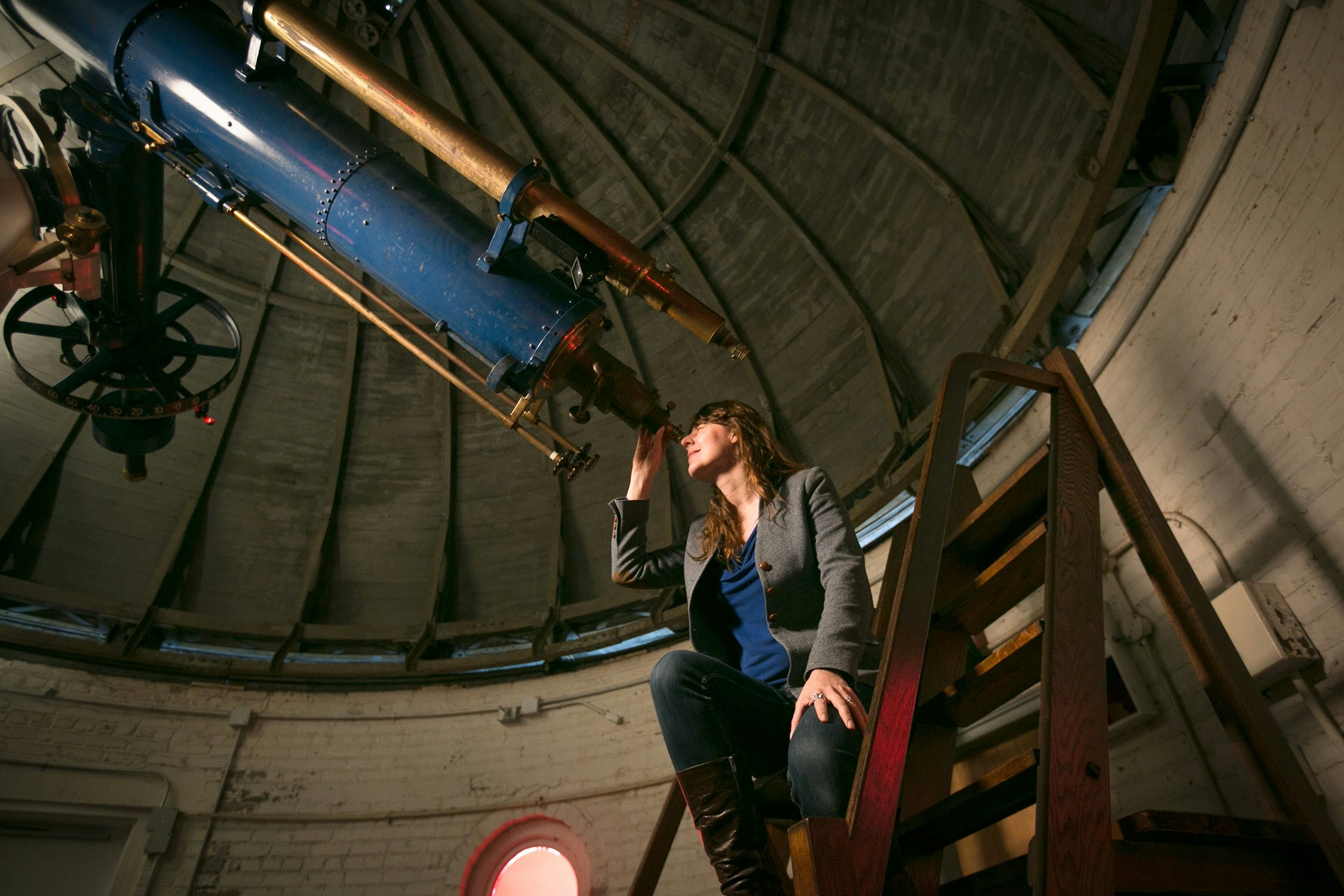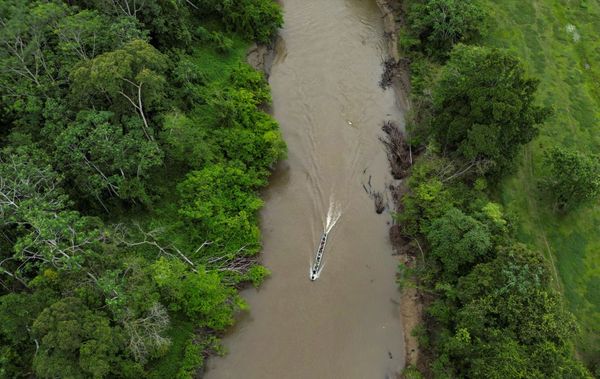
Astrobiologist Lisa Kaltenegger spends her days building miniature worlds.
Kaltenegger and her colleagues study how different species and combinations of bacteria, plants, and fungi change the chemistry of the air around them. They then program all of that data into computer simulations that model how the whole atmosphere of a planet changes as life evolves. She then translates those model atmospheres into the spectrum of light astronomers might see through a telescope like the James Webb Space Telescope (JWST).
Someday, she hopes that the vials of well-tended microbes, tiny samples of hot lava, and thousands of lines of computer code in her labs will help astronomers recognize the chemical signs of life in the atmosphere of a distant planet.
In her recent book, Alien Earths: The New Science of Planet Hunting in the Cosmos, Kaltenegger describes the result as a “light fingerprint” for life (and one of its telltale features is a combination of oxygen and methane).
Inverse talked with Kaltenegger about exoplanets, aliens, and how science mixes caution with optimism.

Inverse: When you began your work simulating the light fingerprints of exoplanet atmospheres in your lab, we hadn’t even discovered a rocky, “Earth-like” planet in the habitable zone of another star yet. In Alien Earths, you describe the moment you found out about the first pair of such planets and what it meant to you. How long did you work on this research before you had a planet to use it on?
Kaltenegger: I started thinking about how to do this in 1999 or 2000, and I really started modeling it around 2004. People were finding the first planets in the habitable zone, but it was with the wobble technique, so we didn't really know their mass; they could still be gas balls or rocks. It took about a decade until 2013, until we found the first Kepler planets in the habitable zone that were small enough to be rocky.
It was a long stretch where there were still some hints that those planets would exist, like from radial velocity measurements, but we just were unsure.
I think when we found that first exoplanet around another star, it was an educated guess that there should be other ones. But the one problem we had was the timeline; that the work would be needed at some point seemed like a logical conclusion, but the problem was, was it going to be within my lifetime? There were people telling me that this was way too far advanced, that this is something nobody would need in our lifetimes. And I usually fall back to this idea that I have on science, that you're basically putting these stepping stones into place. Even if it might not be you who actually can do the observations, the ideas that we put together can vibrate through time.
I usually fall back to this idea that I have on science, that you're basically putting these stepping stones into place. Even if it might not be you who actually can do the observations, the ideas that we put together can vibrate through time.
Your book describes one lab full of colorful microbe colonies in vials, and another where you actually make lava by melting powdered rock samples. That sounds like so much fun! What is your normal work day like?
I work a lot on my computer. What I do most of the time is actually putting these pieces together and putting it into this atmospheric model to figure out how these signs of life would appear to a telescope. I do get to go to the biology lab, to the Earth and atmospheric lab, and to the lava lab.
But I have people who actually have those as their specific things, because otherwise I could get going and forget to feed the bacteria. I could see myself forgetting something critical. In our team, we have a person who trained in microbiology who's growing most of these biota, so that's a big step forward from me killing half of the biota when I tried this. And then we have somebody else whose specific expertise is lava, that actually knows how to handle molten rock. I have to say in my head 'Don't touch it, it's molten rock.'
Your tone in the book is very hopeful. How optimistic are you that we’ll detect life on another planet during your career?
We have billions and billions of possibilities out there, so I think the numbers are forever in our favor. The question is how to spot it, and this is what we are learning.
It requires these databases of signatures, like biopigments, that you could see as mixtures of gases in an atmosphere. It requires you to understand your data well, and to understand the star well. Where we are right now is learning how to take the star's signal out to figure out what's going on with the small planets, and the TRAPPIST-1 system is the one that we've started with. It's really hard to do even with the biggest telescope we have.
We have billions and billions of possibilities out there, so I think the numbers are forever in our favor. The question is how to spot it, and this is what we are learning.
One of the first questions that I asked myself is if you looked at the Earth through time, how long could you have spotted life? Because that was a completely open question. Just in terms of how long Earth's atmosphere has had unique signatures of life, it's about half the planet's lifetime, so 2 billion years. If we assume that the evolution of a planet is the same everywhere, time-wise, then I think we have a great chance to find signs of life. If the evolution of life to do photosynthesis and produce oxygen is faster, then we have a higher chance. If it's slower, then it's going to become more tricky to identify it. But being that generation and the group of people who figure out what this probability is, is actually a fascinating journey.
So how optimistic am I? The bigger surprise to me would be if we find nothing. If life is everywhere it can be, and it developed to leave unique signs, then we have a shot with the JWST in the next 5 to 10 years.
Speaking of TRAPPIST-1, some of the first round of observations with JWST have been pretty discouraging; it looks like the innermost TRAPPIST-1 planets may not have much in the way of atmospheres. What does this mean for the odds of life on rocky worlds in the habitable zones of red dwarf stars?
The problem is that if you make a certain assumption for the model of the star, and you apply it to your data, you get a solution. Then you come to the second observation, and we figure out the star is actually completely different than we thought it was. The problem is that results in error bars that are very big, and those big error bars do not preclude us from saying either way if there's an atmosphere enough, so I'm not worried yet. Once we have beaten down the error bars from the star, if we still don't find anything, then it can exclude things like a Martian atmosphere. But we're not there yet.
Currently, what [the JWST data] means is that we can exclude a 'substantial atmosphere,' but the Earth doesn't have a 'substantial atmosphere.' We never expected the TRAPPIST systems to have 10 or 100 bars of hydrogen and CO2, because they're too small, so it's not really surprising, what we've found.
Let's assume that that we find there is no atmosphere on any of the TRAPPIST-1 planets. That actually doesn't mean that the next M star over will also have planets with no atmosphere. TRAPPIST-1 is of the smallest systems, extremely active, and very tightly packed. In science, we have to be very careful not to take one example and extrapolate it to everything else.
Once you find an exoplanet atmosphere with a mix of chemicals that looks like a fingerprint of life, how do you decide when to make the ‘we found aliens’ claim?
The scientific community generally agrees on something called three sigma detection. When you run the model, and it does machine learning and lots of super cool things to figure out what's in the atmosphere [of an exoplanet], if that signal doesn't hit the three times higher than the noise, a lot of times [those signals] are artifacts. And so we've already seen this when we have the first hints that there could be dimethyl sulfide [in a planet’s atmosphere] — that is like a 1.2 sigma, so not anywhere near this threshold yet.
And then I think what needs to happen is that the data needs to be scrutinized by way more than one team. Because you never know; there could be an error in your model, or there could be something you program differently that gives you better results than other teams.
If two independent teams find a confirmation, then the next step is you put all the criticism you can out there: What else could it be? Like exotic geophysics or photochemistry. That's what I do with the light fingerprints, to say [when a planet] might look like it has life, but it doesn't — under what circumstances do we have to be very careful? It's not to say that I'm not excited every time someboday says 'Oh, this could be life.' But it's like the methane on Mars; I wish for it to be life, but if I have 99 or 100 explanations that don't require life, then as a scientist, I do have to say, 'I wish it were life, but it seems like that it's not.'
The more the planet becomes not Earth-like, the more cautious we have to be with our interpretation of the results.
Your book describes a lot of really strange, interesting planets — some you’ve simulated in your lab, and some you’ve actually studied telescope data from. Of all of them, which do you think would make the most interesting science fiction story?
So, when we found Kepler 62 e and f, the two first Kepler words: Just the vision that this would be a water world, that when you dive in, there would be ice on the bottom of this ocean, which because of the pressure, would be warm ice. There would be waves that would never break.
The other one that I'd love to see a sci-fi novel about is that giant planet we found around the white dwarf. We can only wonder, when the star exploded, did they go underground and shelter through the explosion of the star? Did they have any idea if they could survive this? You know that the white dwarf, even over billions of years, would get colder, so they would actually have to do climate change – create as much CO2 as humanly possible. And so I think that would be a super cool sci-fi plot, where your planet or moon is a spaceship that goes to the exploded planet of a star, and that's where you have to survive.







